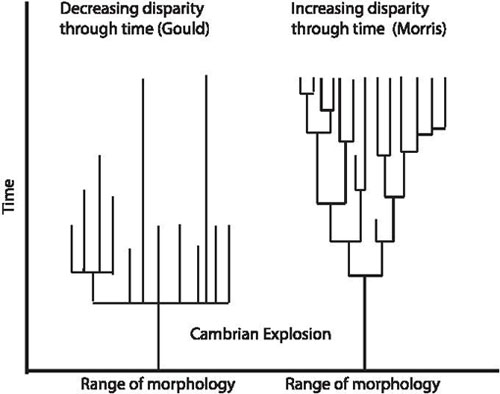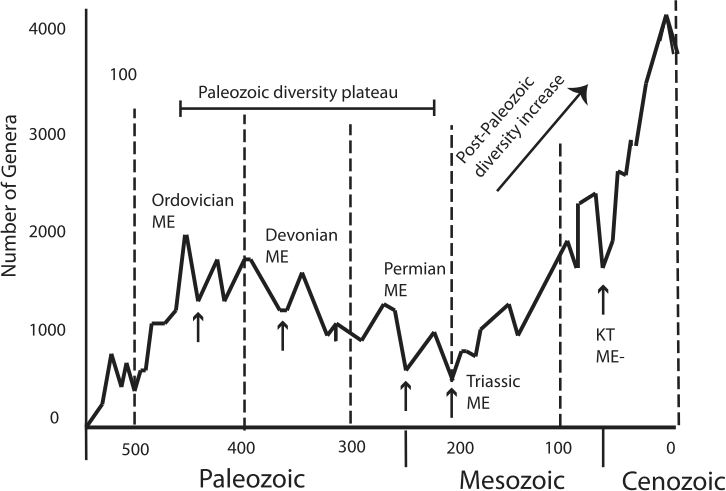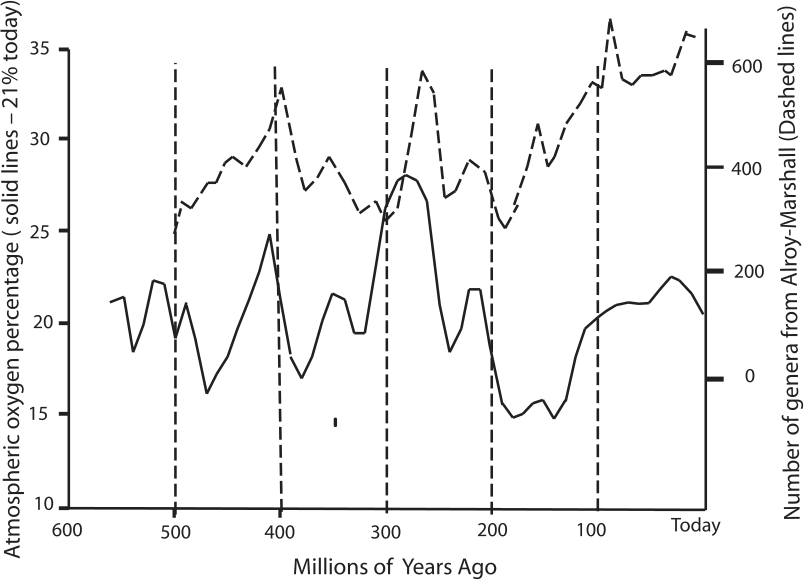A New History of Life (24 page)
Read A New History of Life Online
Authors: Peter Ward

The argument as to whether diversity has shown a rapid increase through time or achieved a high level early on and has stayed approximately steady ever since dominated paleontological research for much of the latter part of the twentieth century. In the 1970s, massive data sets derived from library records began to be assembled by Raup and the late Jack Sepkoski
8
of the University of Chicago along with his colleagues and students. These data, compiling the record of marine invertebrates in the sea, as well as other data sets for both terrestrial
plants and for vertebrate animals, seemed to vindicate Phillips’s early view. In particular the curves discovered by Sepkoski showed a quite striking record, with three main pulses of diversification carried out by different assemblages of organisms.
The first was seen in the Cambrian (the so-called Cambrian fauna, composed of trilobites, brachiopods, and other archaic invertebrates), followed by a second in the Ordovician that led to an approximate steady state through the rest of the Paleozoic era (the Paleozoic fauna, composed of reef-building corals, articulate brachiopods, cephalopods, and archaic echinoderms), culminated by a rapid increase beginning in the Mesozoic and accelerating in the Cenozoic to produce the high levels of diversity seen in the world today through the evolution of the modern fauna, composed of gastropod and bivalve mollusk, most vertebrates, echinoids, and other groups.
The net view of biodiversity over the last 500 million years was thus about the same as that of John Phillips in 1860: there are more
species on the planet now than at any time in the past. Even more comforting, the trajectory of biodiversity seemed to show that the engine of diversification—the processes producing new species—was in high gear, suggesting that in the future the planet would continue to have ever more species. While not at the time viewed in any sort of astrobiological context, these findings certainly do not suggest that planet Earth is in any sort of planetary old age. All in all, the 130-year belief, from the time and work of John Phillips to that of John Sepkoski—that there are more species now than any time in the past—remained a comforting view. This long-held scientific belief suggested to many that we are in the best of biological times (at least in terms of global biodiversity), and there is every reason to believe that better times, an even more diverse and productive world, still lie ahead, even without weird contributions from biotechnology.

Competing hypotheses about disparity and the Cambrian Explosion.
Diversity
refers to the number of species, whereas
disparity
refers to the number of different kinds of anatomies, or body plans. Stephen Jay Gould thought that there were many more body plans (high disparity) during the Cambrian Explosion than now. He referred to many of the strange fossils from the Burgess Shale as “weird wonders” and thought that they were phyla now entirely extinct. The opposite view was held by Simon Conway Morris, who advocated that disparity has slowly increased through time.
While the Sepkoski work seemed to show a world where runaway diversification is a hallmark of the Late Mesozoic into the modern day, worries about the very real sampling biases described by earlier workers persists, and a series of independent tests of diversity were conducted. Of most concern was a phenomenon dubbed the “pull of the recent”—that the methodology used by Sepkoski would undercount diversity in the deep past, making it look like there were ever more species in more recent times. Because of this very real concern, new tests were devised to examine biological diversity through time. In the early part of the new millennium the issue was reexamined
9
by a large team headed by Charles Marshall of Harvard (now at Berkeley) and John Alroy, then at the University of California at Santa Barbara. This team assembled a more comprehensive database, based on actual museum collections rather than using Sepkoski’s method of simply tabulating the number of species recorded in the scientific literature for given intervals of past geologic time. To virtually everyone’s surprise, the first results of this effort were radically different from the long-accepted view.
The analyses of the Marshall-Alroy group found that diversity in the Paleozoic was about the same as in the mid-Cenozoic. The dramatic run-up of species that had so long been postulated for diversity through
time was not evident in this new study. The implications are stark: we may have reached a steady state of diversity hundreds of millions of years ago. It may be that diversity peaked early in the history of animals, and in contrast to all views since the time of Phillips, it has remained in an approximate steady state since, or perhaps may already be in decline. While many new innovations, such as the adaptation allowing the evolution of land plants and animals, surely caused there to be many new species added to the planet’s biodiversity total, it may be that by late in Paleozoic time the number of species on the planet has been approximately constant.
Thus, following an initial burst of diversification in the lower Cambrian, animal diversity increased exponentially to reach equilibrium during the Paleozoic and then crashed at the end of the Permian, followed by an overall trend of increasing diversity, but importantly interrupted by short intervals of diversity decreases—the mass extinctions—of which five were particularly consequential. While these mass extinctions each led to substantial loss of taxa, all were followed by increased rates of species formation that led to levels not only equaling but in each case exceeding the original diversity prior to the extinction event.
This history suggests that a complex array of factors causing both diversification and extinction are responsible for the observed pattern of Phanerozoic diversity. Among the many potential factors that have been invoked to explain the observed increases in diversity are evolutionary innovation, the colonization of previously empty or unobtainable habitats, and the occurrences of new resources, while the major factors cited for diversity drops are changes in climate, reduction of resources or habitat area, new biological competition or predation, or external events such as asteroid impact.
Geochemists have long known that CO
2
levels and atmospheric oxygen levels show trends that are inversely related to one another: when oxygen levels rise, CO
2
is usually dropping. While it is difficult to understand how changing levels of CO
2
at concentrations that have little or no direct biological effect on individual organisms could somehow promote or inhibit diversification, it is quite plausible to
suggest that it was not the changing CO
2
but in fact a combination of changing oxygen levels, with that change being affected by global temperature rates.


Top graph: The trajectory of marine invertebrate animal diversity from the Cambrian Period onward, as discovered by Jack Sepkoski. His findings, based on long and prodigious library research, indicated that the numbers of genera rose quickly in the Paleozoic and then plateaued, only to be cut down by the Permian Mass Extinction. Afterward, he saw a great rise in generic numbers to the present day. Bottom graph: Here we show the levels of oxygen, as modeled by Robert Berner, with newer (than Sepkoski) estimates of animal generic numbers published by John Alroy and others. Notice the strong correlation between peak oxygen levels (both high and low) and the trajectory of animal numbers. (From Peter Ward, unpublished results.)
Cold water holds more oxygen than warm. In a cold world, with already high oxygen levels, life in the sea would rarely be
compromised by too little oxygen. On the other hand, in a warm world where there was already relatively little oxygen, most bodies of nonflowing water would quickly go stagnant. And not just ponds to lakes—large oceans would succumb to this as well in a warm world, which is what a high CO
2
world is.
The data to date suggests that (at least for marine animals) overall, global taxonomic diversity is related to oxygen content, which might be expected, since all animals have a poor tolerance for anoxic conditions. What was
unexpected
was the finding that origination rates (measured either in species or genera, which are groups of related species all with the same common ancestor) appear to be
inversely
correlated to oxygen levels. The high levels of origination characterizing the period from 545 to roughly 500 MA (the Cambrian explosion) occurred during a protracted period of oxygen levels of between 14 and 16 percent, compared to 21 percent today. The dramatic rise in oxygen in the Silurian and again in the Carboniferous corresponds with the
lowest
levels of generic origination. The drop of oxygen in the Permian is correlated to a rise in origination rates but a drop in the total number of species. There seems to be a clear signal.
Times of high oxygen are like the boom times in a country’s economy. There is little unemployment and businesses succeed and stay open—but not many new ones start up. Start-ups, it seems, are related to bad times. New ideas play out and new risks are taken in times of desperation. Yet while there are many new start-ups, few of them succeed, and at the same time many of the businesses that were succeeding during good times begin to fail at an ever-higher rate in the bad times.
Thus we see a dichotomy: more new businesses appear, but most of them quickly go bankrupt and disappear along with many of the previously successful. There is also less money circulating. The total number of businesses plummets. The same seems to be true of species. High oxygen means good times: large numbers of species, and nothing much new comes along. But when oxygen is low, species die out at a faster rate than they are replaced, even though the actual number of emerging species is higher than in the high-oxygen times.
There are many examples. One of the best: the long-term rise in oxygen beginning in the Jurassic and continuing to the modern day is accompanied by both a long-term drop in origination rates and a huge run-up in diversity. But what radical new designs appear? Birds, mammals, reptiles, amphibians—all of the Cenozoic forms are slight changes of body plans that originated in either Paleozoic or Mesozoic bad times, the low-oxygen times. There are no dinosaurs (the best examples of a radical innovation spawned directly from low oxygen) appearing in the Cenozoic.
The recognition that a combination of low oxygen and elevated carbon dioxide has stimulated species formation in the past by the formation of evolutionary novelty, while at the same time vastly increasing extinction rates, has a firm biological basis. The net effect is the reduction of species during the low-oxygen periods. Dropping oxygen levels with concomitant rising temperatures is the worst kind of one-two punch, as adapting to hotter, lower-oxygen environments is never a quick fix. More hair, more feathers, and more body fat can fix increasing cold. But staying cool is far more difficult and involves much more profound evolutionary change. This is even more true in animals trying to deal with staying alive in ever-lowering oxygen, since adaptation to lower oxygen levels is necessarily profound and must occur in multiple organ systems, ranging from blood pigments to more efficient circulatory systems, to better lungs or gills.